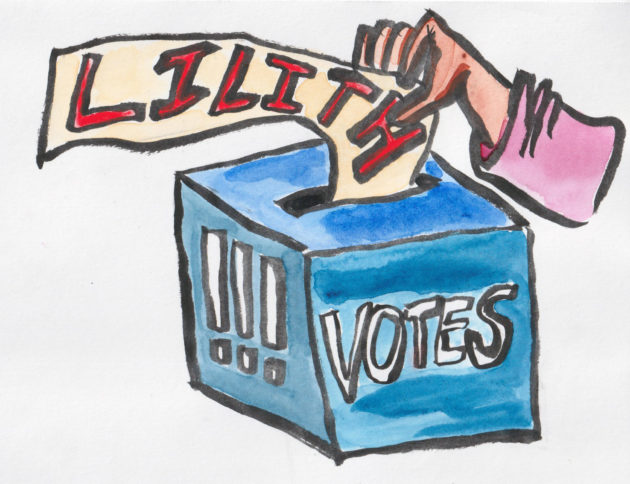
by Arielle Silver-Willner
Lilith Votes: The Truth about Voter Suppression

During my first year of college, I registered to vote at a picnic table in front of the Student Center. The student running the event, a volunteer for the Bernie Sanders campaign, shared my excitement about voting in our first-ever election for a candidate that we “actually liked.” I filled out the registration form carefully, verified that I would be 18 before the 2016 Democratic primary, and slipped the paper into an official-looking box.
I grew up in New York, but had decided to register locally in Connecticut so that I could vote in person. I envisioned myself as a “civically engaged youth,” doing my part to push our country further toward justice.
During my Sophomore spring, the long-awaited day arrived. A friend drove me to the local high school after class, and I waited in line nervously to cast my vote. When my turn came, the poll worker asked for my name and began to flip through her binder. I watched her scan the page where my identification information should have been, sweat gathering under my arms. “It doesn’t look like you’re registered,” the woman told me. I was baffled. “I registered over a year ago,” I told her. She shrugged and double-checked her records. “Are you a student at Connecticut College?” she finally asked. I told her I was. She sighed and explained to me that I was not the first Conn student that day whose registration seemed to be missing. She apologized and asked me to step aside. Baffled, I exited the building.
Confused and discouraged, I did what any flustered college kid would do—I called my mom. She assured me that this was not normal and told me to call the Board of Elections, while she called several other state offices. After waiting on hold and describing my problem to multiple Board of Election representatives, I was advised to submit an appeal, which was useless. The primary would be over by the time my appeal could be resolved. So I decided to give up, re-register in New York, and request an absentee ballot for the general election.
Back on campus, I discovered that several of my peers who had also planned to vote for Bernie Sanders had been turned away from the poll as well. The student volunteer who had delivered the registration forms to City Hall was outraged. Nobody could understand what had happened. Perhaps our box of forms had simply been lost in the bureaucratic shuffle?
It soon became clear, however, that our assumption of clerical error was naive. I began to hear about similar instances of “missing registrations” in other cities, particularly in college towns and other liberal bubbles, as well as in communities with predominantly Black and Latinx populations. Rumors of election interference were beginning to surface. I had yet to vote, but I was already feeling disillusioned with the U.S. democratic process. Sure, I had heard whisperings about corruption during past elections, but as a younger teenager I had never paid much attention. Now, I realized, it was time to start noticing.
After the 2016 election, I began to hear about “voter purging,” the legal process of identifying and deleting the registrations of those who have not voted recently, in order to “clean up” the voter rolls and, supposedly, prevent fraud. However, there are frequent cases of illegal purging (whether in error or intentionally), and a significant portion of the population may be removed from the voter rolls without notice. Isn’t it risky to assume that someone who has skipped as few as two elections is not interested in voting in the future? And why is our government willing to sacrifice so many valid registrations in order to prevent such an uncommon problem?
According to the Brennan Center for Justice, between 2016-2018 the voter purge rate in New London County (where I attended college) was 4.7%. In some parts of the country the rate was as high as 15%. Nationally, between the 2014 and 2016 elections, “16 million voters were purged.” And studies show that rates are highest in communities of color and liberal-leaning towns and cities. This “use it or lose it” attitude toward voter registration reveals a major flaw in our country— it seems that voting is not in fact a right, but a privilege.
Learning about voter purging has motivated me to volunteer with several grassroots organizations, writing to citizens in communities known to experience it the most. But purging is not the only form of voter suppression. A recent addition to the growing list of barriers to democratic participation is concern about the reliability of voting by mail. Currently, the precarious state of the USPS is a major political issue, given the anticipated increase in those who may choose mail-in voting in the November 2020 election because of the Covid-19 pandemic. The USPS has struggled financially for years, but recent threats from the current administration are widely perceived as an intentional attack on the electoral process.
I am immunocompromised and considered “high-risk” for Covid. Voting in person may put me in danger, but I feel uneasy about voting by mail. It has been four years since I experienced my first taste of the poison in our democratic system, and I fear that it was only the beginning.
Of course, I will still cast my vote this fall, whether it means mailing in my ballot several weeks early or donning a hazmat suit to brave the polls. But I will also continue to fight for a better, truer democracy.
—
Feeling lost? Start by making your voting plan:
Check your voter registration status
Request an absentee (mail-in) ballot if you think you may need one
Find out when to send in your absentee ballot